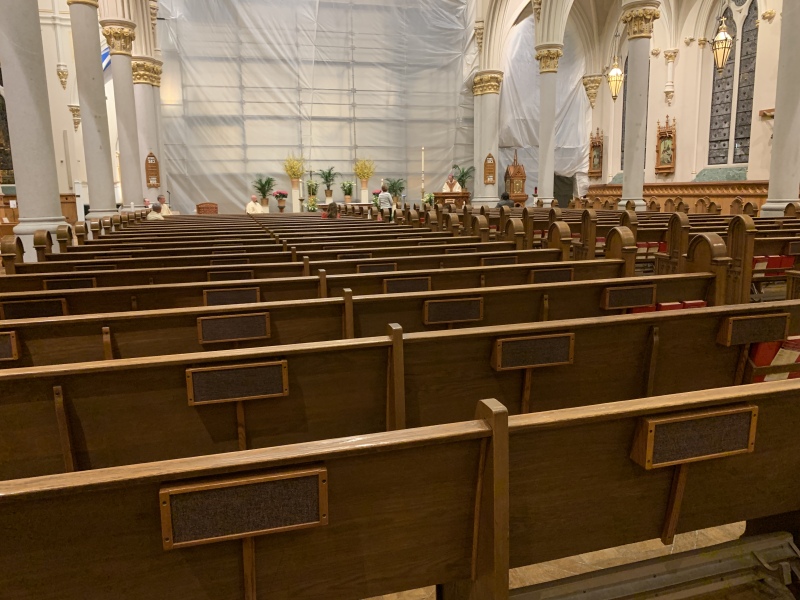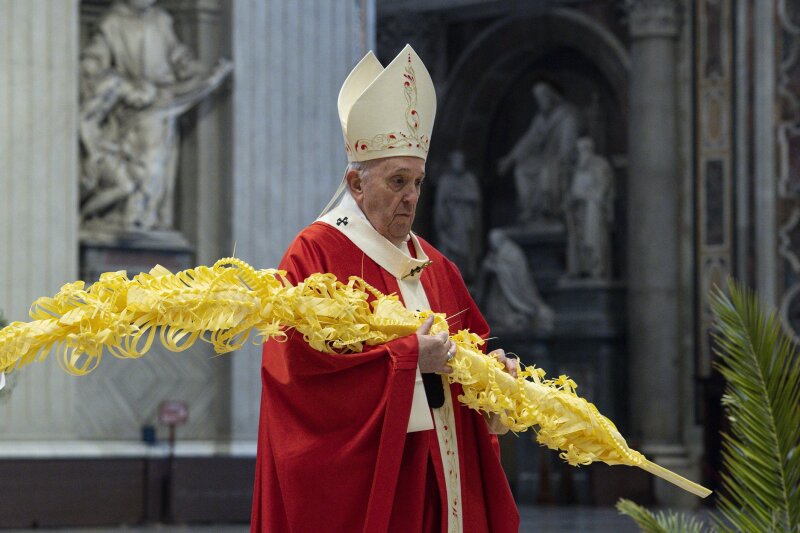
OUR LONG LENT IS FAR FROM OVER — BUT SIGNS OF EASTER ARE EVERYWHERE
Catholic News Service
03/29/2021
Responding to editors' requests for a regular sampling of current commentary from around the Catholic press, here is an unsigned editorial titled: "Our long Lent is far from over — but signs of Easter are everywhere," published online March 18 by "America" magazine, a national Catholic publication based in New York.
More than a year ago, the COVID-19 pandemic changed the lives of every human being on earth. The virus has claimed more than 2.6 million lives, including more than 500,000 in the United States. The U.S. unemployment rate hit nearly 15 percent last spring, the highest since the Great Depression.

St. Peter Cathedral on April 11, 2020. Photo/Anne-Marie Welsh
Many COVID-19 victims died alone, denied the presence of their loved ones at their side, and their funerals were sparsely attended or not held at all. Many families are still waiting for permission to have funerals. The pandemic taught us the phrase "social distancing" and created a physical and often emotional distance in our society.
Grandparents have gone without hugs and kisses from their grandchildren for months on end. Travel restrictions and safety precautions put dampers on family gatherings. Weddings and baptisms have been small.
A growing distrust of information and authority figures has spawned heated divisions among loved ones on a range of pandemic-related issues, from the need for mask-wearing to the efficacy and morality of COVID-19 vaccinations.
Social isolation has taken its toll on everyone. Countless Catholics across the country have gone a year without attending Mass in person. A number of crucial church outreach initiatives, like prison ministry, have been on hiatus. The pandemic has inflicted a mental toll on health workers, children and young adults.
Many children are still attending school virtually. From the onset of the pandemic, teachers had to adapt quickly to online learning. Today, many are charged with essentially teaching two classes simultaneously, one for in-person students and the other for virtual learners.
Many students, particularly from lower-income communities, have struggled. Educators and government leaders scrambled to provide internet connections and devices suitable to the new learning environment.
Yet Christians, despite death and suffering, know there is always reason to hope. Easter reminds the faithful of our obligation to maintain hope in the darkest of times. And while our long Lent may seem far from over, there are nevertheless signs of resurrection.

St. Peter's Basilica at the Vatican March 28, 2021.
CNS photo/Vatican Media
The speed at which researchers developed COVID-19 vaccines is a testament to the creative ingenuity that is possible when society works together for the common good. As of this writing, over 60 million Americans have received at least one dose of a vaccine, as the nation quickly approaches immunizing 20 percent of the population.
Hundreds of millions of vaccine doses are expected to be available within the next few months. On average, over 2 million doses are being administered each day, according to the Centers for Disease Control and Prevention. President Joe Biden has vowed to deliver enough vaccinations for every U.S. adult by the end of May. Most high school students could be vaccinated this fall.
With immunization will come a return to many of the things society has gone without during the pandemic. For believers of all faiths, it will mean a return to in-person religious services for the first time in more than a year; for many Catholics, it also will mark the return to access of the sacraments.
Some couples who have waited until it would be possible to have a large gathering will finally celebrate their weddings. Others will finally get to make that long-planned pilgrimage to the Holy Land or visit their relatives in other countries where travel restrictions have been prohibited.
It has been a long battle, but the pandemic will end eventually. Some economists are projecting a boom in jobs this year based on businesses reopening, a federal stimulus package providing a financial boost to struggling families and consumers spending the savings they accumulated during lockdown. They project the unemployment rate could drop below 4 percent.
Many of us are now experiencing a greater appreciation of things we previously took for granted — especially essential workers. We are grateful for doctors, nurses, police and firefighters, but also have discovered the essential work of those overlooked in the past.
We now recognize the irreplaceable labor of food service workers, agricultural laborers, maintenance personnel and child care providers, many of whom are part of our immigrant underclass.
Despite social distancing measures, there is a growing sense of connectedness among fellow Americans in lockdown. We now cherish simply being in public spaces, from parks and beaches to grocery stores and movie theaters.
In March, for example, spring training baseball games welcomed small crowds that observed social distance guidelines, a welcome return to what has been an American rite of passage for 150 years.
The pandemic has called forth society's generosity. People have stepped forward to help those in need, including many who have never needed help before. Many have reorganized their priorities, placing social connection at the top. In a country that has always celebrated individualism, we are newly appreciating the value of community.
Indeed, the suffering of the pandemic has perhaps begun to dismantle the American mirage of rugged individualism. As the disciples supported each other in the early days of Christianity, so too has the world joined together to face this common threat.
We now see how truly interdependent we are. Humanity shares a common destiny. Our health and survival is interconnected with the health and survival of our neighbors. Our success in struggling against the pandemic has been possible only because we have fought this battle together.
Easter is also a time when new Christians are welcomed into the church. Let us rejoice with them as they profess their new faith in Christ, who overcame death.
And despite the death and suffering that we have endured, let us stand together in the sure and certain hope of better things to come — the hope so well expressed by Jesuit Father Gerard Manley Hopkins: "Let him easter in us, be a dayspring to the dimness of us."
Editor's note: The views or positions presented in this or any guest editorial are those of the individual publication and do not necessarily represent the views of Catholic News Service or of the U.S. Conference of Catholic Bishops.
-
